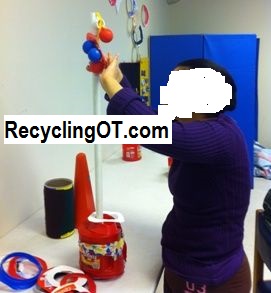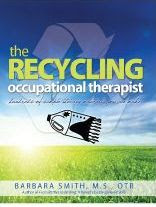In my book
From Flapping to Function: A Parent's Guide to Autism and Hand Skills I describe some of the factors that impact functional vision. Functional vision is not the same as acuity but rather the ability to use visual information to perform functional tasks such as reading, writing and catching a ball. Of course,
acuity or
focusing power are important for functional vision but there are several other skills that are important in order to scan the environment, follow moving objects and persist at longer visual tasks.

Children with autism may have difficulties with one or more of what is called " the 7 Fs. "These are:
1) Following a moving target using smooth, coordinated eye movements
2) Fixation to gaze at a stationary object
3)Focus to see clearly
4) fusion to use the eyes together to see in 3 dimensions
5) Flexibility to look back and forth between different things
6) Field or the breadth of what the eyes can see while staring straight ahead. For example, people with glaucoma may have extremely diminished visual fields to the point of using "tunnel vision". Children with autism may not seem to be aware of what is in their visual field.
8) Fatigue- is eye strain from the effort put into using the eyes. Also some people with autism tend to use side or peripheral vision and using peripheral is more tiring than using the direct central gaze.
My son discovered that he was a very slow reader and was exhausted after reading for 15 minutes due to his eyes not working together. A developmental optometrist gave him helpful exercises to do .
Parents and others may notice that their child with autism does not look directly at objects or may look briefly directly and then look away while picking them up. Other atypical behaviors include stimulating the visual system by flicking fingers or an object near the eyes (often from the side of the eyes) or staring at lights.
- They may be particularly bothered by fluorescent lights
- seek out darkened areas, perhaps play in a tent or large cardboard box to avoid lights
- have difficulty using the eyes together or
- moving the gaze back and forth between distances or from vertical to horizontal planes.
My son avoids sunlight when possible, and can only sleep in a very darkened room while wearing eye covers. He can do a Rubiks cube in under 2 minutes !
Here are a couple of adaptations that I describe in my book in greater detail.
FOR YOUNGER CHILDREN:
- Use Velcro to attach puzzle pieces to the top of the box lid. (see photo above)
- Attach puzzle board to the bottom of the box with tape or Velcro
Children will need to use one hand to stabilize the box lid while removing the puzzle piece. The child will need to repeatedly switch gaze back and forth between the vertical and horizontal planes. This is a type of visual flexibility, number 5 in the above list.
The skill of being able to look back and forth between distances and planes is also called
Accommodation . It is used when students look back and forth between the board and desk to copy from board to paper. It may be difficult to fixate on the word on the board, find the last word on the paper to continue writing and then go back to the board to again find where one left off reading.
There are some compensatory strategies that teachers can implement to help students such as allowing them to sit closer to the board or have a copy at the desk to copy from instead of copying from the board.
Here is a visual activity that parents can do at home......
FOR OLDER CHILDREN

Tape cards, words or pictures on the wall and provide identical cards at the table or desk. Start out with 2-3 cards that are fairly close together on the wall and gradually increase the number used and spread them further apart. As you can see in the photo I then looked back and forth in order to arrange the cards to be in the same sequence.
YOUNGER CHILDREN
Try this activity using simple pictures or photos. Try using number or letter cards to teach some numerical or alphabetical sequencing at the same time.
I hope that these tips, adaptations and activities are helpful. If you have any questions about your child's functional vision please check with a developmental optometrist who specializes in working with children with these types of challenges. Check out this website to find one...
http://www.covd.org/


































